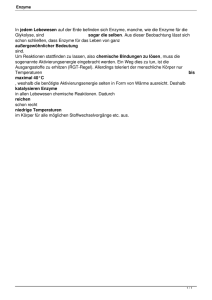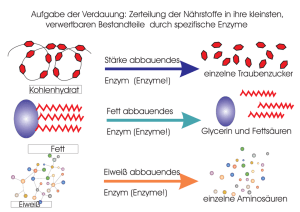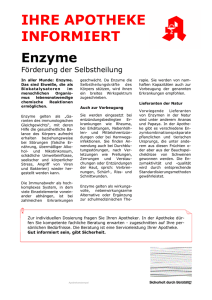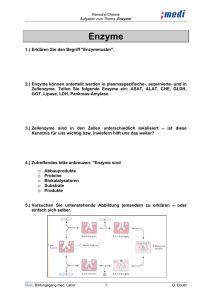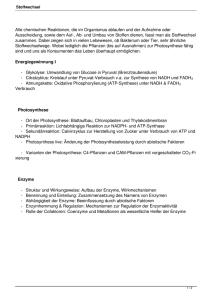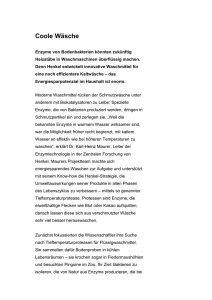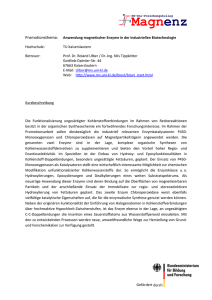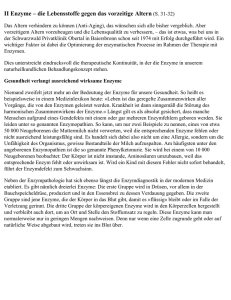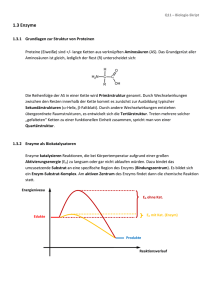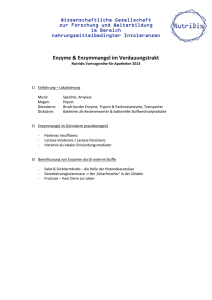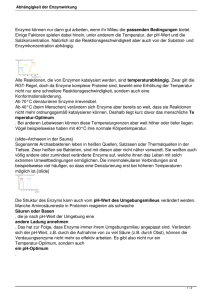Empfehlungen der Deutschen Gesellschaft für Klinische Chemie
Werbung
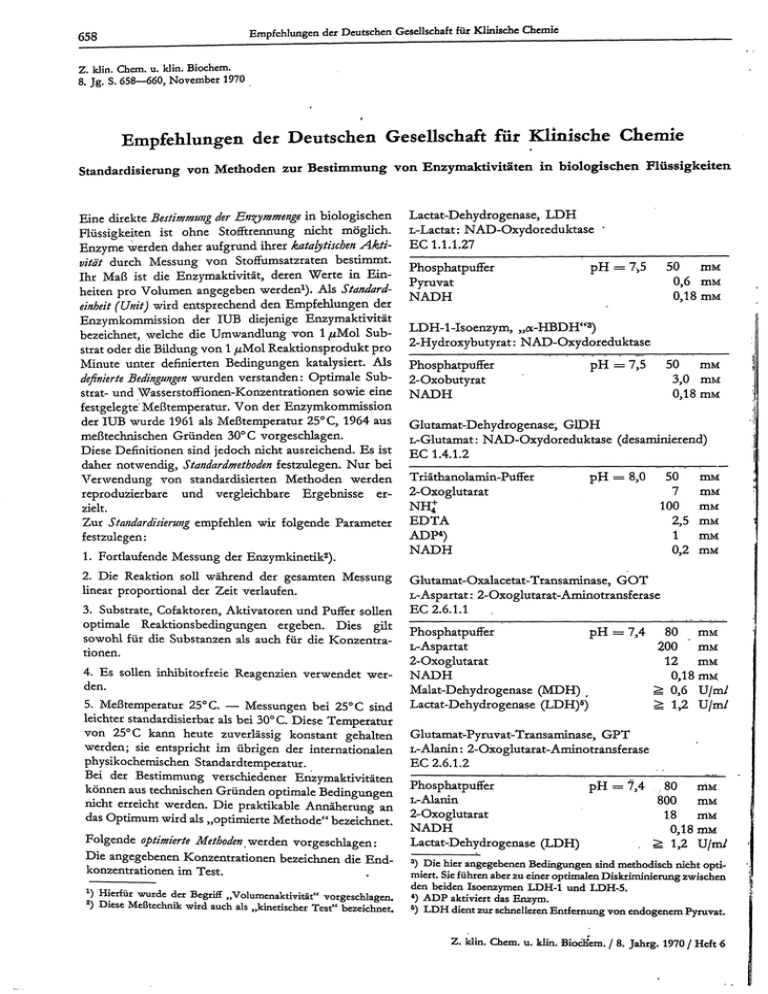
Empfehlungen der Deutschen Gesellschaft für Klinische Chemie 658 Z. klin. Chem. u. klin, Biochem. 8. Jg. S. 658—660, November 1970 Empfehlungen der Deutschen Gesellschaft für Klinische Chemie Standardisierung von Methoden zur Bestimmung von Enzymaktivitäten in biologischen Flüssigkeiten Eine direkte Bestimmung der En^ymmenge in biologischen Flüssigkeiten ist ohne Stofftrennung nicht möglich. Enzyme werden daher aufgrund ihrer kataljtischen Aktivität durch Messung von Stoffumsatzraten bestimmt. Ihr Maß ist die Enzymaktivität, deren Werte in Einheiten pro Volumen angegeben werden1). Als Standardeinheit (Unit) wird entsprechend den Empfehlungen der Enzymkommission der IUB diejenige Enzymaktivität bezeichnet, welche die Umwandlung von l //Mol Substrat oder die Bildung von l ! Reaktionsprodukt pro Minute unter definierten Bedingungen katalysiert. Als definierte Bedingungen wurden verstanden: Optimale Substrat- und Wasserstoffionen-Konzentrationen sowie eine festgelegte Meßtemperatur. Von der Enzymkommission der IUB wurde 1961 als Meßtemperatur 25° C, 1964 aus meßtechnischen Gründen 30° C vorgeschlagen. Diese Definitionen sind jedoch nicht ausreichend. Es ist daher notwendig, Standardmethoden festzulegen. Nur bei Verwendung von standardisierten Methoden werden reproduzierbare und vergleichbare Ergebnisse erzielt. Zur Standardisierung empfehlen wir folgende Parameter festzulegen: 1. Fortlaufende Messung der Enzymkinetik2). 2. Die Reaktion soll während der gesamten Messung linear proportional der Zeit verlaufen. 3. Substrate, Cofaktoren, Aktivatoren und Puffer sollen optimale Reaktionsbedingungen ergeben. Dies gilt sowohl für die Substanzen als auch für die Konzentrationen. 4. Es sollen inhibitorfreie Reagenzien verwendet werden. 5. Meßtemperatur 25° C. — Messungen bei 25° C sind leichter standardisierbar als bei 30° C. Diese Temperatur von 25° C kann heute zuverlässig konstant gehalten werden; sie entspricht im übrigen der internationalen physikochemischen Standardtemperatur. Bei der Bestimmung verschiedener Enzymaktivitäten können aus technischen Gründen optimale Bedingungen nicht erreicht werden. Die praktikable Annäherung an das Optimum wird als „optimierte Methode" bezeichnet. Folgende optimierte Methoden wenden vorgeschlagen: Die angegebenen Konzentrationen bezeichnen die Endkonzentrationen im Test. x ) Hierfür wurde der Begriff „Volumenaktivität" vorgeschlagen. ) Diese Meßtechnik wird auch als „kinetischer Test" bezeichnet. 2 Lactat-Dehydrogenase, LDH L-Lactat: NAD-Oxydoreduktase EC 1.1.1.27 Phosphatpuffer Pyruvat NADH 50 0,6 0,18 pH = 7,5 LDH-1-Isoenzym, „*-HBDH"3) 2-Hydroxybutyrat: NAD-Oxydoreduktase Phosphatpuffer 2-Oxobutyrat NADH 50 3,0 0,18 IHM pH = 7,5 Glutamat-Dehydrogenase, G1DH L-Glutamat: NAD-Oxydoreduktase (desaminierend) EC 1.4.1.2 Triäthanolamin-Puffer 2-Oxoglutarat pH = 8,0 EDTA ADP4) NADH 50 7 100 2,5 1 0,2 mM mM mM mM mM Glutamat-Oxalacetat-Transaminase, GOT L-Aspartat: 2-Oxoglutarat-Aminotransferase EC 2.6.1.1 Phosphatpuffer pH = 7,4 80 L-Aspartat 200 mM 2-Oxoglutarat 12 NADH 0,18 Malat-Dehydrogenase (MDH) , ^ 0,6 U/m/ Lactat-Dehydrogenase (LDH)5) ^1,2 U/m/ Glutamat-Pyruvat-Transaminase, GPT L-Alanin: 2-Oxoglutarat-Aminotränsf erase EC 2.6.1.2 Phosphatpuffer pH = 7,4 . 80 niM L-Alanin 800 mM 2-Oxoglutarat 18 mM NADH 0,18 niM Lactat-Dehydrogenase (LDH) ^ 1,2 U/m/ 3 ) Die hier angegebenen Bedingungen sind methodisch nicht opttmiert. Sie führen aber zu einer optimalen Diskriminierung zwischen den beiden Isoenzymen LDH-1 und LDH-5. 4 ) ADP aktiviert das Enzym. ) LDH dient zur schnelleren Entfernung von endogenem Pyruvat. Z. Idin. Chem. u. klin. BiocKem. / 8. Jahrg. 1970 / Heft 6 Recommendations of the German Society for Clinical Chemistry Creatin-Kinase, CK (aktiviert) ATP: Creatin-Phosphotransferase EC 2.7.3.2 Leutin-Arylamidase, „LAP" Tris-Puffer L-Leucin-4-nitranilid Nad«) Triäthanolamin-Püffer p H = 7,0 100 mM 35 mM Creatinphosphat 20 mM Glucose 0 .. Glutathion 10 mM Magnesium-Acetat 1,0 IHM ADP 0,6 mM NADP Glucose-6-phosphat-DehydroS 1,2 U/m/ genase (G6P-DH) Hexokinase (HK) ^ 1,2 U/m/ p H= 9 , 8 pH = 7,5 50 4 250 Der experimentelle Beleg für die Empfehlung dieser optimierten Bedingungen und die hierfür geltenden Normbereiche werden in weiteren Mitteilungen der Deutschen Gesellschaft für Klinische Chemie veröffentlicht. Die Kommissionen für Enzymdiagnostik und Standardisierung, gezeichnet H. U. Bergmeyer H. Büttner G. Hillmann F. H. Kreutz H. Lang D. Laue Alkalische Phosphatase, AP Orthophosphorsäuremonoester-Phosphohydrolase EC 3.1.3.1 Diathanolamin-Puffer 4-Nitrophenylphosphat Mg2+ 659 I M 10 mM 0,5 mM W. Rick E. Schmidt F. W. Schmidt D. Stamm G. Szasz 6 ) NaCl verhindert Trübungen des Testansatzes. Recommendations of the German Society for Clinical Chemistry Standardisation of methods for the estimation of enzyme activity in biological fluids The amount of an enzyme in a biological fluid cannot be estimated directly by analytical methods. Therefore, enzymes are estimated by their catalytic activity, i. e. by measuring the rate of substrate conversion. The measure is the enzyme activity, which is expressed as units per volume1). According to the recommendations of the Enzyme Commission of the IUB the standard unit is defined as that enzyme activity, which catalyzes the conversion of 1 substrate, resp. the formation of 1 reaction product per minute under specified conditions. The specified conditions are: optimal pH and substrate concentration as well as defined temperature. In 1961 the Enzyme Commission of the IUB, proposed 25° C as the standard temperature, and then in 1964, for technical reasons, 30° C. However, these definitions are not sufficient. It is essential to establish standard methods, because only by using standardized methods reproducible and comparable results will be obtained. For standardisation we recommend the following conditions : The term "volume activity" has been proposed for this value. Z. klin. Chem. u. klin. Biochem. / 8. Jahrg. 1970 / Heft 6 1. Continuous monitoring of enzyme kinetics2). 2. The reaction rate should be constant during the whole period of observation. 3. The kinds and concentrations of substrates, cofactors, activators and buffers should result in optimal reaction conditions. This relates to substances as well as to the concentrations. 4. Reagents should be free of inhibitors. 5. Measurement temperature is 25° C. Measurements at 25° C are easier to be standardized than at 30° C. A temperature of 25° C can be kept constant and it conforms with the international temperature for physico-chemical data. The optimal conditions for the determination of activities of some enzymes are not technically attainable. The practicable approximation to the optimum is called "optimized method". The following optimized methods are proposed: The given concentrations are the final concentrations in the test. 2 ) This technique is also called "Kinetic Test". 87*

